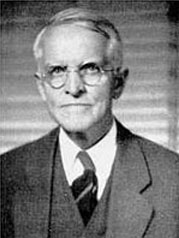Wesley Clair Mitchell facts for kids
Quick facts for kids
Wesley Clair Mitchell
|
|
|---|---|

Wesley Clair Mitchell
|
|
| Born | August 5, 1874 Rushville, Illinois, U.S.
|
| Died | October 29, 1948 (aged 74) New York City, U.S.
|
| Nationality | American |
| Institution | NBER 1920–45 Columbia University 1913–44 UC Berkeley 1903–12 University of Chicago 1899–1903 |
| Field | Political economics Macroeconomics |
| School or tradition |
Institutional economics |
| Alma mater | University of Chicago |
| Doctoral advisor |
J. Laurence Laughlin |
| Doctoral students |
Simon Kuznets Arthur F. Burns Raymond J. Saulnier |
| Influences | Thorstein Veblen John Dewey |
| Contributions | Empirical research on Business cycles |
Wesley Clair Mitchell (born August 5, 1874 – died October 29, 1948) was an American economist. He was famous for studying how economies grow and shrink over time, which are called business cycles. He also helped lead the National Bureau of Economic Research (NBER) when it first started.
Many people thought Mitchell was a brilliant student of Thorstein Veblen, another important economist. A famous economist named Paul Samuelson even called Mitchell one of the "American saints in economics."
Contents
Mitchell's Early Life and Education
Wesley Clair Mitchell was born in Rushville, Illinois. He was the second child and oldest son in his family. His father was a doctor who served in the Civil War and later became a farmer.
Wesley's family had seven children. His father had some health issues and took big risks in business. This meant Wesley, as the oldest son, had a lot of responsibility. Despite these challenges, he went to the University of Chicago. He earned his PhD degree in 1899.
Mitchell's Career and Teaching
Mitchell had a long and successful career as a researcher and teacher. He started as an instructor at the University of Chicago in 1899. Later, he became a professor at the University of California, Berkeley. He also taught at Harvard University for a short time.
From 1914 to 1944, Mitchell was a full professor at Columbia University. In 1916, he was chosen as a Fellow of the American Statistical Association. This showed how much people respected his work with numbers and data.
Mitchell also helped start two important organizations. He was one of the founders of the New School for Social Research. He taught there between 1919 and 1922. He also helped create the National Bureau of Economic Research (NBER) in 1920. He was the director of research at NBER until 1945.
Government Work and Influence
During the First World War, Mitchell took breaks from his teaching to work for the government. He served on many government committees. From 1929 to 1933, he was the chairman of the President's Committee on Social Trends.
In 1923 and 1924, he was the president of the American Economic Association. Mitchell also represented the United States at the World Population Conference in Geneva, Switzerland, in 1927.
The National Bureau of Economic Research (NBER) was where Mitchell had the most impact. He worked closely with other important economists there, like Arthur Burns and Simon Kuznets. Kuznets later said that Mitchell taught him a great deal. Mitchell also made valuable contributions to understanding the history of economic thought.
Mitchell's Family Life
Wesley Mitchell was married to Lucy Sprague Mitchell. She was a very important educator and started the Bank Street College of Education. Wesley helped his wife when she was founding the school.
Mitchell's Key Economic Work
Early Research at Chicago
At the University of Chicago, Mitchell learned from famous teachers. These included economists Thorstein Veblen and J. L. Laughlin. He also learned from the philosopher John Dewey. Veblen and Dewey greatly shaped Mitchell's ideas.
Laughlin was Mitchell's main advisor for his PhD paper. Laughlin was very interested in how money works in an economy. Mitchell's paper, called A History of the Greenbacks, looked at what happened when the US government used paper money during the Civil War. His later study, Gold Prices and Wages Under the Greenback Standard, also looked at how the US economy behaved in the past using lots of data.
Studying Business Cycles
Mitchell's biggest project was studying and measuring the business cycle. This is how economies regularly go through periods of growth and then slowdowns. This topic became a very important problem in economics. His most famous book, Business Cycles, came out in 1913.
In this book, Mitchell looked at many different ideas about why business cycles happen. He believed that all of them seemed possible. Mitchell's way of doing research was different from others. He didn't start with one idea and then try to find proof. Instead, he gathered lots of facts and data first.
Measuring Business Cycles with Data
Thirty years later, Mitchell was still working on business cycles. He published another big book called Measuring Business Cycles with A.F. Burns. This book showed the special methods used by the National Bureau of Economic Research to study business cycles.
Mitchell was known as an "empirical scientist." This means he focused on collecting and analyzing real-world data. He believed that economic theories should come from what we observe in the world. He thought that business cycles were a natural part of how capitalism works. Mitchell was greatly influenced by Veblen and is often seen as an "institutionalist" economist. This means he looked at how institutions and customs affect the economy, not just simple rules.
See also
 In Spanish: Wesley Clair Mitchell para niños
In Spanish: Wesley Clair Mitchell para niños
- Economic Cycle Research Institute

